CarEdge saved me over 4,500 dollars on a brand new Honda Pilot. I can't say thank you enough.
Price intelligence
Find a wide range of vehicle listings with market insights on new and used listings near you.
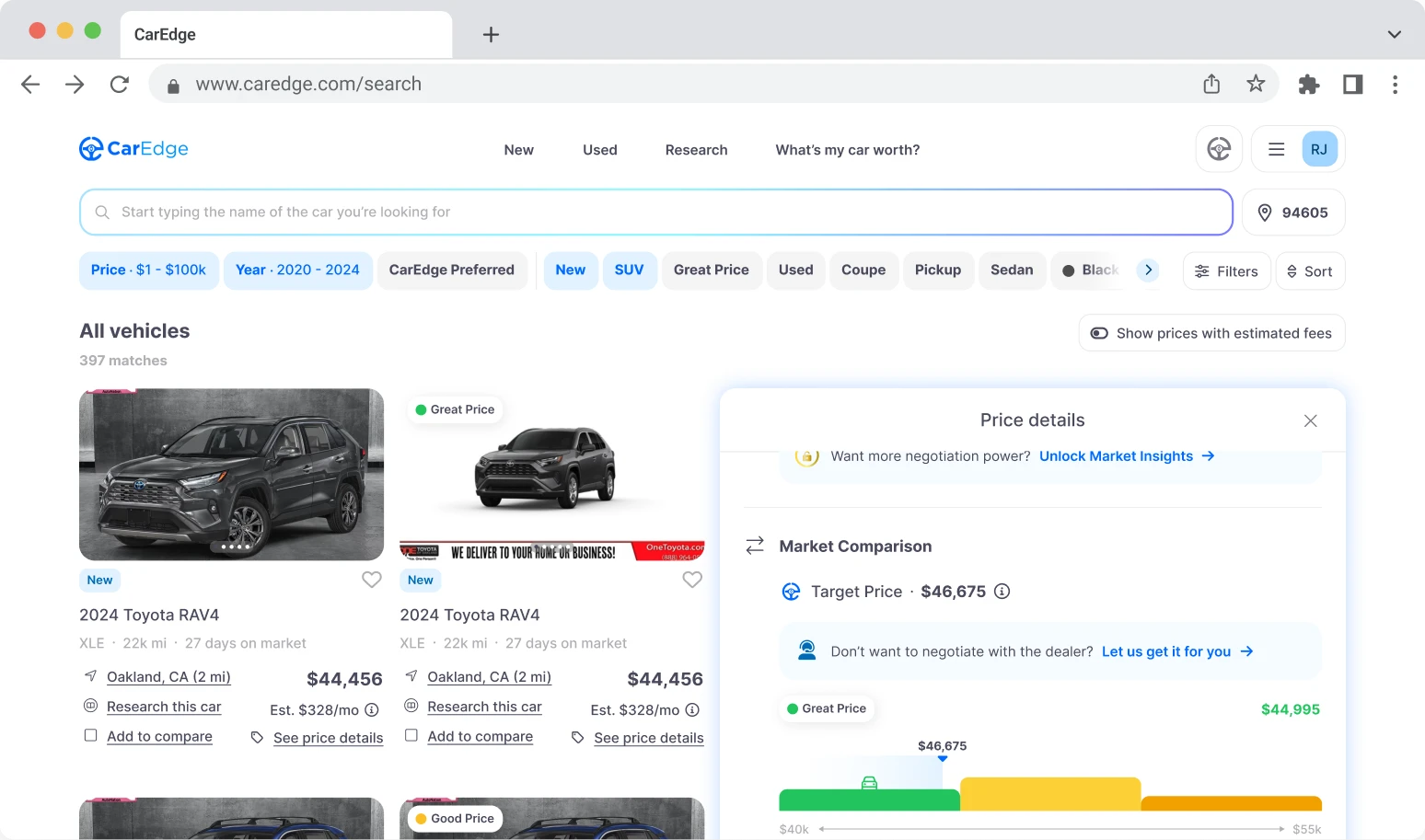

Help us personalize your CarEdge experience — it only takes a second.
Your answers help us personalize your CarEdge journey — we’ll follow up with tips and next steps that match your buying timeline.
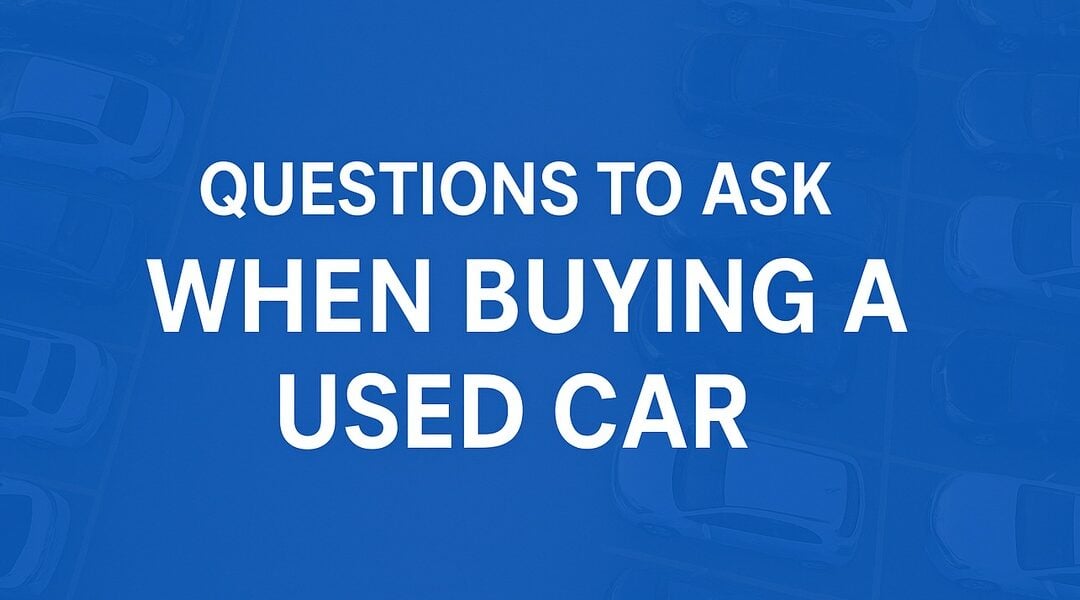
Buying a used car can be a smart financial decision — if you ask the right questions. Pre-owned vehicles come with unique risks, from hidden damage to unclear pricing. That’s why it’s crucial to go into the process prepared and confident.
Use this guide to make sure the dealership (or private seller) is giving you the full picture. If they dodge any of these questions, consider it a red flag.
Used car prices often vary by dealership, but the OTD price reveals the real cost, including taxes, fees, and dealer-installed accessories.
👉 Use our free Out-the-Door Price Calculator to compare offers.
The longer a used car sits, the more room there is to negotiate. A vehicle that’s been on the lot for 45–60+ days may come with bigger discounts.
📊 Use CarEdge Pro to check days on lot, supply, and local market pricing.
A Carfax or AutoCheck report should be free and readily available. It reveals accidents, maintenance, and ownership history.
🚨 No history report = red flag. Walk away if they won’t provide one.
It’s important to note that if you’re buying a used car from a private seller, you may need to purchase your own vehicle history report. All you’ll need is the car’s VIN.
A Pre-Purchase Inspection (PPI) can uncover hidden mechanical issues that a dealer won’t mention. This step alone can save you thousands.
Pro tip: Always choose an independent mechanic who’s not affiliated with the seller.
Used cars can vary greatly, even within the same make, model, and year. A test drive helps you catch mechanical concerns and ensure comfort. Drive on a variety of road surfaces at low and high speeds.
Take note: A test drive doesn’t replace the need for a pre-purchase inspection by an independent mechanic.
Used cars may still have factory warranty remaining or include a dealer-backed warranty. Ask for details, and if they’re selling you an extended warranty:
Compare to CarEdge Extended Warranty plans for full transparency. No markups, just clear coverage.
Buying from a private seller can sometimes get you a better deal. However, it comes with more risk and fewer protections than buying from a dealership. That’s why it’s critical to ask the right questions up front.
Here are some additional questions you should ask a private party seller before agreeing to buy a car:
💡 Pro Tip: Bring a printed bill of sale template and ensure both parties sign it. Also, double-check your local DMV requirements for title transfers and taxes before finalizing anything. See some examples here, but always ensure that all required fields are on your form.

Buying used doesn’t mean buying blind. Let CarEdge’s car buying service do the legwork:
✅ We find the best pre-owned vehicles
✅ We negotiate pricing and review contracts
✅ We coordinate inspections, delivery, and paperwork
Learn more about how CarEdge can help.
CarEdge is your trusted partner for smarter used car shopping. We provide expert tools, unbiased insights, and negotiation support — so you never overpay. Start your car search at CarEdge.com and take control of your next purchase.

Understanding what’s on a new car’s window can save you from overpaying or falling for dealer tricks. If you’ve ever heard the terms Monroney sticker or window sticker and felt confused — you’re not alone. These labels are crucial for transparency when buying a car, and every buyer should know what to look for.
In this guide, we’ll break down what a Monroney sticker is, why it exists, and how to read it. You’ll leave feeling more confident and equipped to understand what a car really includes — no matter what a salesperson might tell you.
Before car buyers had access to standardized pricing, buying a car was like walking into the Wild West. Salespeople could pick and choose what to tell you — and what to charge.
That all changed with the creation of the Monroney sticker, a federally mandated label that must be displayed on every new car for sale in the U.S. You’ll also hear it referred to as the window sticker — they’re the same thing.
This label lists everything a shopper needs to know about the car’s equipment, price, and origin. It was designed to protect buyers and level the playing field.
Only 9% of Americans say car salespeople have high ethical standards — the lowest of any profession according to Gallup. That’s why federal law stepped in.
Here’s what’s included on every Monroney sticker:
Check out an example of where you’ll find this important information:
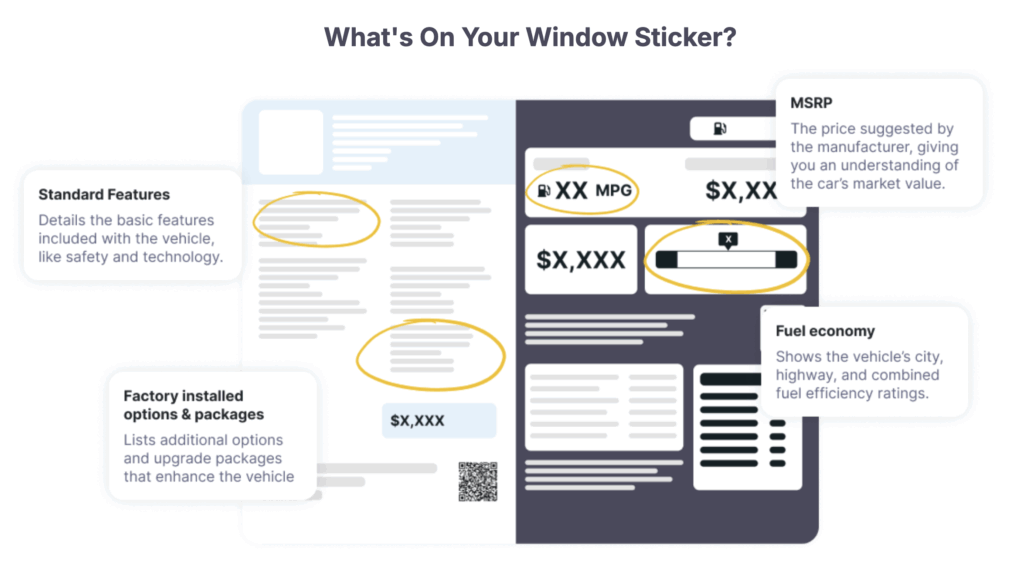
📌 Important: Dealer-installed accessories (like pinstripes, floor mats, or nitrogen tires) are not listed on the Monroney sticker. They appear on a separate dealer addendum sticker, which is not federally regulated.
The name comes from Senator Almer “Mike” Monroney, who sponsored the Automobile Information Disclosure Act of 1958. Signed into law by President Dwight Eisenhower, the act required automakers to include standardized labels on all new cars.
Before this law, car buyers had no way to verify what was included in a vehicle or whether the price was fair.
Monroney was a leader in consumer protection and also played a role in creating the Federal Aviation Administration (FAA). His legacy lives on every time you look at a new car’s window sticker.
Want to learn more about the law? Visit the Consumer protection Branch at the U.S. Department of Justice.
Let’s recap what you’ll find on a new car’s Monroney (window) sticker. This information is required by law and cannot be altered or removed by dealers:
💡 Tip: If you don’t see this sticker on a new car, ask why — and consider walking away.
So you’re standing on a dealership lot — where should your eyes go first?
The Edmunds guide to reading a window sticker is an excellent visual breakdown. You can view it here, but here’s a quick summary:
In today’s car market, dealer markups and confusing add-ons are everywhere. But the Monroney sticker keeps it real — it’s the one label they can’t legally change.
When you’re comparing similar vehicles across different dealerships, the window sticker helps you:
Whether you’re shopping used or just want to do your research from home, you no longer have to visit the lot to see the original window sticker. CarEdge now offers access to digital Monroney stickers on most vehicles — giving you instant insight into the car’s features, options, and MSRP breakdown.
✅ Great for used cars that originally included premium options
✅ Helps compare trim levels and original pricing
✅ Saves time and reveals red flags before you visit the dealership
View the original window sticker — and shop smarter from the start.
Q: Is a Monroney sticker required by law?
A: Yes. Every new car for sale in the U.S. must display a Monroney sticker — it’s federal law.
Q: Are Monroney and window stickers the same thing?
A: Yes. These two terms refer to the same federally required label.
Q: Can dealers alter or remove the Monroney sticker?
A: No. It’s illegal for dealers to modify or remove the sticker prior to sale.
Q: Does the window sticker include dealer add-ons?
A: No. Only manufacturer-installed options are listed. Dealer-installed accessories appear on a separate sticker.
Q: Do used cars have a Monroney sticker?
A: No. The law only applies to brand-new vehicles. However, used vehicles may have copies of the original sticker or digital replicas provided by the dealer.
Founded by industry veterans, CarEdge is your trusted resource for transparent car buying. From understanding pricing to negotiating deals and avoiding scams, we provide data-backed insights, expert tools, and concierge services to help you buy with confidence.Want help with your next car purchase? Let us find and negotiate the best deal for you! Explore CarEdge’s car buying help today.
A few years ago, a typical car deal would include thousands of dollars of “incentives” to help a dealership seal the deal with a customer. Nowadays, new car incentives are few and far between. As the ongoing chip shortage (and new magnesium shortage) have hampered automakers, we’ve seen a drastic decline in new car incentives.
Incentives traditionally take the form of either cash rebates or special financing programs. Cash rebates are going by the wayside as vehicle supply cannot keep up with consumer demand. Because of this imbalance automakers do not need to subsidize the purchase of their vehicles. Many consumers are perfectly content buying at MSRP (or above).
Special finance programs still exist, however most industry analysts expect them to fad away as well as interest rates inevitably increase due to inflationary pressures.
TrueCar tracks incentives for most major OEMs. We’ve compiled that data here for you.
The table below makes it very clear; new car incentives are being cut left and right.
| Manufacturer | Q3 2021 | Q3 2020 | Q2 2021 | YoY % Change | QoQ % Change |
| BMW | $3,929 | $5,340 | $4,713 | -26.4% | -16.6% |
| Daimler | $3,135 | $5,621 | $3,574 | -44.2% | -12.3% |
| Ford | $2,569 | $4,241 | $2,564 | -39.4% | 0.2% |
| GM | $3,062 | $5,515 | $4,399 | -44.5% | -30.4% |
| Honda | $2,013 | $2,580 | $2,167 | -22.0% | -7.1% |
| Hyundai | $1,560 | $2,547 | $2,102 | -38.7% | -25.8% |
| Kia | $2,336 | $3,428 | $2,549 | -31.9% | -8.4% |
| Nissan | $2,661 | $4,519 | $3,502 | -41.1% | -24.0% |
| Stellantis | $2,892 | $4,903 | $3,522 | -41.0% | -17.9% |
| Subaru | $1,382 | $1,851 | $1,339 | -25.3% | 3.2% |
| Toyota | $1,992 | $2,726 | $2,219 | -26.9% | -10.3% |
| Volkswagen Group | $2,939 | $4,421 | $3,730 | -33.5% | -21.2% |
| Industry | $2,478 | $3,997 | $3,003 | -38.0% | -17.5% |
GM, who lost their US sales crown to Toyota is cutting back most heavily when it comes to incentives. This makes sense, because GM inventory levels are down 80%+ in most states right now. With no new vehicles to sell, it makes sense why GM would cut back on incentives.
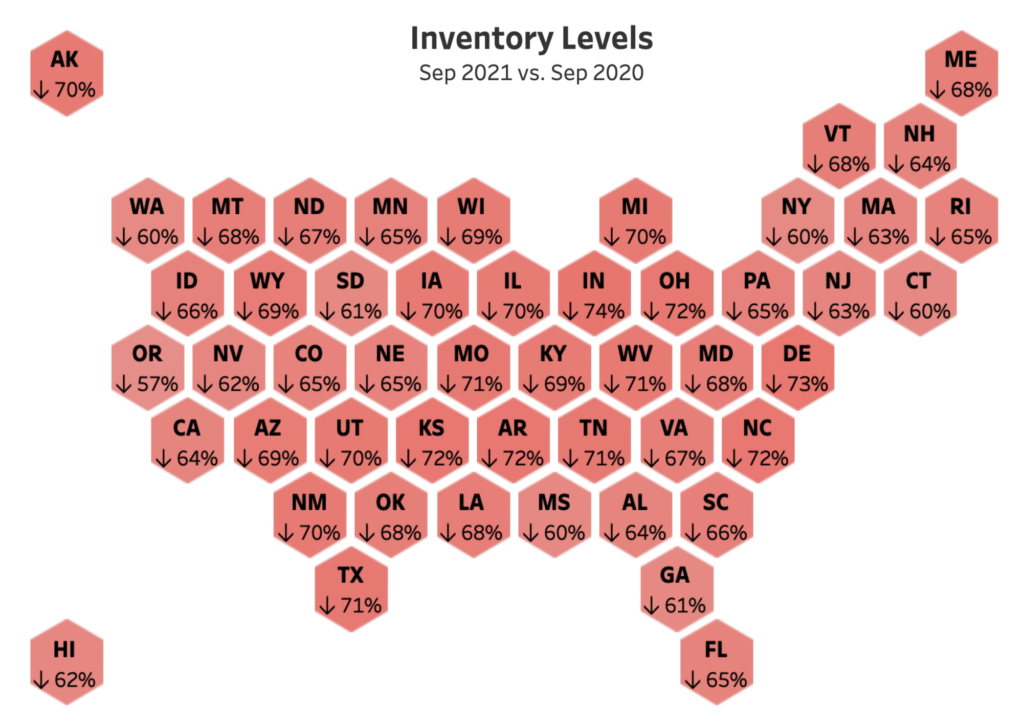
Hyundai and Nissan have also cut their incentives aggressively quarter-over-quarter. This indicates that they may be struggling more than their peers when it comes to production of vehicles.
As a whole, the industry has experienced a 38% reduction in new car incentives year-over-year for the third quarter.
Digging into the data on a month-to-month level is fascinating. We can actually see that the month-over-month changes are more drastic, indicating that the reduction in new car incentives is more aggressive today than it was at the beginning of Q3.
| Manufacturer | Sep 2021 Forecast | Sep 2020 Actual | Aug 2021 Actual | YOY | MOM |
| BMW | $3,246 | $5,120 | $4,142 | -36.6% | -21.6% |
| Daimler | $3,039 | $5,715 | $3,086 | -46.8% | -1.5% |
| Ford | $2,850 | $4,539 | $2,381 | -37.2% | 19.7% |
| GM | $2,314 | $5,438 | $2,894 | -57.4% | -20.0% |
| Honda | $1,940 | $2,468 | $1,987 | -21.4% | -2.4% |
| Hyundai | $1,310 | $2,708 | $1,481 | -51.6% | -11.5% |
| Kia | $2,169 | $2,991 | $2,236 | -27.5% | -3.0% |
| Nissan | $2,500 | $4,491 | $2,474 | -44.3% | 1.1% |
| Stellantis | $2,987 | $5,079 | $2,970 | -41.2% | 0.6% |
| Subaru | $1,420 | $1,844 | $1,329 | -23.0% | 6.8% |
| Toyota | $1,883 | $2,705 | $2,145 | -30.4% | -12.2% |
| Volkswagen Group | $2,690 | $4,311 | $2,763 | -37.6% | -2.6% |
| Industry | $2,326 | $4,028 | $2,422 | -42.3% | -4.0% |
BMW and GM have decreased their new car incentives the most, followed by Toyota. Ford and Subaru have both increased their new car incentives. This is surprising, because Subaru has a very limited supply of inventory, and Ford isn’t fairing too much better.
The industry as a whole has slashed new car incentives 42% year-over-year for the month of September. There is no indication that this will get “better” before the end of the year, and many automakers are excited to get rid of incentives because it allows them to save money.
We can also see a decline in incentives as a percentage of the average transaction price (ATP) of a new vehicle.
| Manufacturer | Sep 2021 Forecast | Sep 2020 Actual | Aug 2021 Actual | YOY | MOM |
| BMW | 5.3% | 8.5% | 6.9% | -38.1% | -23.8% |
| Daimler | 4.7% | 9.8% | 4.7% | -52.1% | 0.7% |
| Ford | 6.0% | 10.5% | 5.0% | -43.0% | 19.1% |
| GM | 5.0% | 13.0% | 6.5% | -61.9% | -23.6% |
| Honda | 6.0% | 8.2% | 6.3% | -26.2% | -4.3% |
| Hyundai | 3.9% | 9.1% | 4.6% | -57.2% | -14.4% |
| Kia | 7.6% | 11.1% | 8.0% | -31.9% | -6.0% |
| Nissan | 7.9% | 15.8% | 7.9% | -50.0% | 0.2% |
| Stellantis | 6.2% | 11.7% | 6.3% | -47.1% | -1.3% |
| Subaru | 4.7% | 6.2% | 4.3% | -24.1% | 9.8% |
| Toyota | 5.1% | 8.0% | 6.0% | -35.6% | -15.3% |
| Volkswagen Group | 6.8% | 10.7% | 6.8% | -37.0% | -0.3% |
| Industry | 5.9% | 11.0% | 6.3% | -46.4% | -6.3% |
To understand this table, simply look at BMW. In September of 2020 incentives accounted for 8.5% of the average transaction price of a BMW. That means that if you were buying a $100,000 BMW you would expect $8,500 in incentives. Today the expectation should be $5,300 in incentives. As new car incentives decline, and average transaction prices increase, incentives as a percent of average transaction price is also falling.
“Deal” is relative in this market. The short answer is “yes,” the long answer is, “it depends.” We have seen many CarEdge members secure new cars at MSRP with no additional dealer markup. In this market, that’s a GOOD deal. A lot of your dealmaking ability will have to do with the amount of inventory the dealership has available for sale. Some automakers are also still offering incentives on factory orders, so if you are okay with waiting for your new car, placing an order might make sense for you.
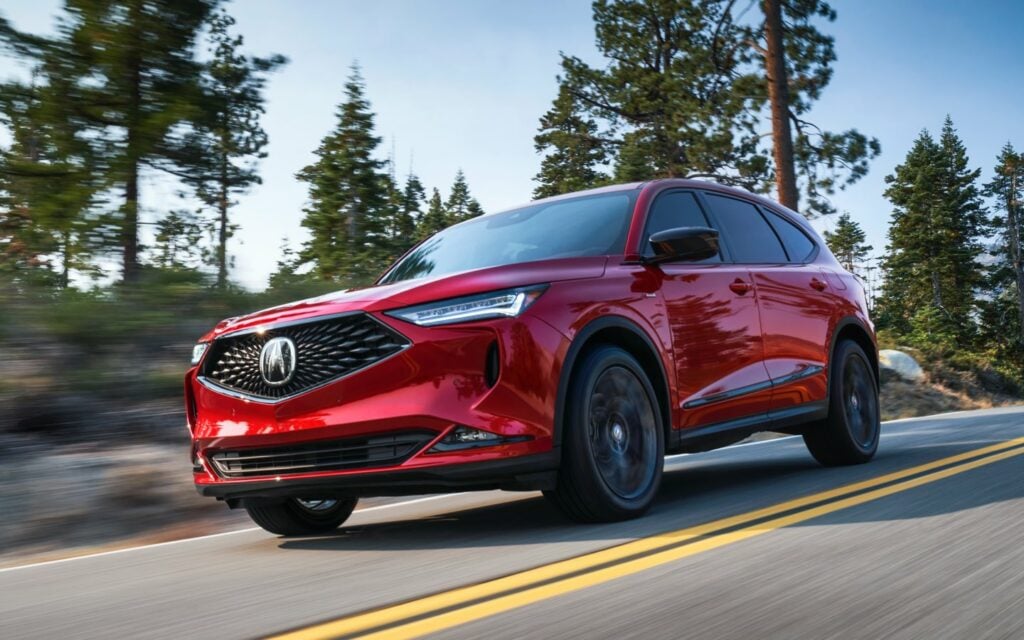
Buying a car is already a complex process, and purchasing a vehicle in another state can make it even more overwhelming. With inventory levels fluctuating, many car buyers are expanding their search beyond to find the right vehicle at the best price. We’ll walk you through the entire process, from understanding the steps involved to figuring out tax requirements and transportation logistics.
Buying a vehicle in another state is eerily similar to buying a car at your local dealership with a few exceptions. The steps to the sale are:
At a high level, that’s how you buy a car in another state. Let’s break each step down a bit further.
As with any car deal, the first step is to negotiate the OTD price with the salesperson or sales manager. When buying a vehicle in another state you’ll likely be unfamiliar with their taxes and fees. It is incredibly important that you tell the dealership what your zip code is so that they can calculate your taxes and fees based on your location. We’ll touch on this more below, but taxes are paid where you register your vehicle, not where you purchase it. If the dealership doesn’t know your zip code, they won’t be able to provide you with an accurate out the door price quote.
We strongly recommend that you reference the CarEdge OTD Price Calculator to verify that the dealership’s OTD price matches up with the correct tax, title, and registration rates in your state.
Do you know what happens if you arrive at the dealership without a competitive financing pre-approval in hand? The finance office will be THRILLED because to the dealership, they instantly realize they have the upper hand.
Dealers routinely mark up finance offers before presenting them to customers. It’s one way they make money. Be sure to bring a competitive financing offer from a credit union!
If you’re purchasing a used vehicle from another state there are a few extra considerations you should be aware of. First, you should absolutely consider arranging for a pre-purchase inspection to make sure the vehicle is in good working condition. Second, you’ll need to ensure the vehicle can pass your state’s inspection and emissions testing. By conducting a pre-purchase inspection you’ll likely become aware of any issues that would preclude the vehicle you’re thinking of buying from passing your state’s inspection.
To arrange for a pre-purchase inspection from out of state you have a few options:
After an inspection report has been received and you’ve agreed to an OTD price, you’ll want to place a deposit down on the vehicle. When buying a vehicle in another state, the last thing you want to do is fly there, or arrange shipping, only to see the price change at the eleventh hour. To protect yourself from last minute changes, place a deposit on the vehicle, and also request to sign a copy of the buyer’s order. Request that the sales manager at the dealership does the same too.
The final step in the out of state purchase process is to take delivery of the vehicle. This is when you will meet with the Finance and Insurance Manager to review loan options and insurance products. As with buying a vehicle locally, you can (and should) come in pre-approved with outside financing and extended warranty coverage quotes.
Depending on what state you are purchasing the vehicle from, you may be able to “take delivery” remotely (sign all the paperwork electronically) and have the vehicle shipped to you. More on that below.
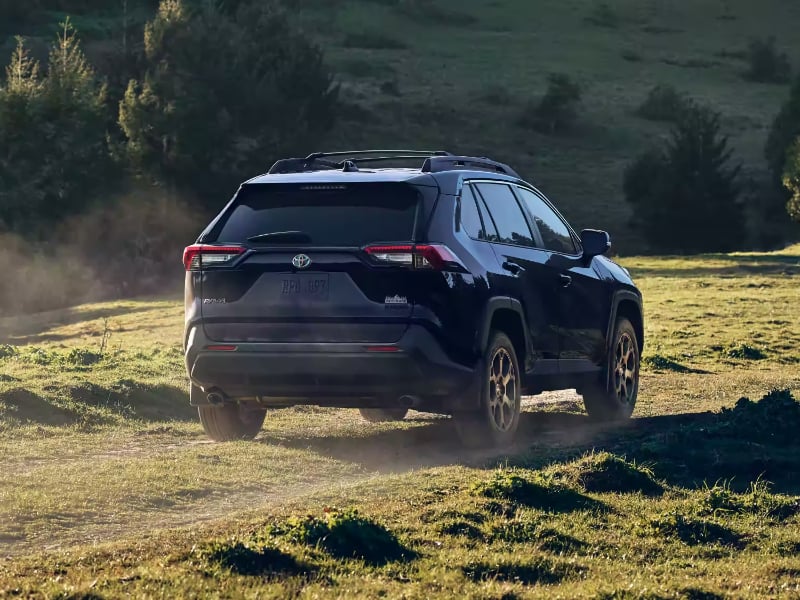
Yes, if you buy a car in another state you can drive it back home to where you live. Unless of course you decide to buy a car in the state of Massachusetts …
In every state except Massachusetts you will receive a temporary license plate from the state where you purchased the vehicle. This temporary tag (also referred to as “drive off tags”) will allow you to legally operate the vehicle after purchasing it.
When you arrive back in your home state you will then go to your local department of motor vehicle and register the vehicle. This is when you will receive your permanent plates for the vehicle.
Why is Massachusetts different from all the other states? That’s a great question. Their laws around vehicle registration are infuriatingly complex and cumbersome. Auto Influence wrote a great article on the Massachusetts Problem here: https://www.autoinfluence.com/the-ins-and-outs-of-temporary-plates/
When you purchase a vehicle out of state, you pay taxes in the state where you register the vehicle, not where you purchased it. The actual process of calculating the correct tax amount and remitting it to your home state can be handled differently.
For example, if it’s a neighboring state, the dealership where you purchase the vehicle will collect and remit the taxes and fees for you. You’ll then receive your permanent plates and registration in the mail. Many dealerships have software that allows them to calculate the proper sales tax and registration fees for different states, and in neighboring states they may feel comfortable handling that for you.
If you’re buying from a further away state, or if the dealership doesn’t offer to handle tax and registration remittance for you, you should contact the dealership’s title department to see if they can walk you through the steps you’ll need to take back in your home state. At this point it is also helpful to consider contacting a local dealership and asking them for assistance too. If you have a local tax professional they would also be able to help. You can of course also refer to your state and local tax laws and remit payment on your own.
Let’s say you purchase out of state and you pay for sales tax, but it is the wrong amount. What happens then? When you go to register your vehicle at your local department of motor vehicle you will either receive a credit from them, or you will owe them additional money.
Yes, absolutely. This is a very common practice and could financially make a lot of sense for you. The dealership where you purchase the vehicle may recommend a particular shipping company and you should see what their quote is. You should also shop the quote and get bids from other providers as well.
Shipping options will range from open air freight to closed container shipping.
When you buy with CarEdge, we ship your vehicle to you. Learn more about the benefits of buying with CarEdge.
Yes. The registration process is different in each state, however you can buy a vehicle in one state and register it in your home state. You’ll need to make sure the vehicle can pass your state’s emissions test and road worthiness inspection.
You’ll also need to confirm that the vehicle title is clear of any liens.
If you’re buying a vehicle in another state and you have a trade-in, you should strongly consider treating your trade-in as a separate transaction from your purchase. More on that here: https://caredge.com/guides/car-trade-in/
Yes, you can lease a vehicle from another state, however some dealership’s will not allow you to. The complexity of out-of state leases is high, and some dealerships do not want the burden of mistakenly calculating the wrong taxes and fees on a lease. Before negotiating an OTD price with an out of state dealership, we would encourage you to ask them if they’re willing to lease you the vehicle with you being from another state. Be prepared to give them your zip code since each state treats leases differently.

In conclusion, buying a vehicle in another state can seem like a daunting task, but with the right knowledge and guidance, it can actually be a smart move that saves you money. By taking the time to research the laws and regulations in the state you plan to buy from, and working with a reputable dealer or private seller, you can find the car of your dreams without breaking the bank.
Ready to outsmart the dealerships? Download your 100% free car buying cheat sheets today. From negotiating a deal to leasing a car the smart way, it’s all available for instant download.
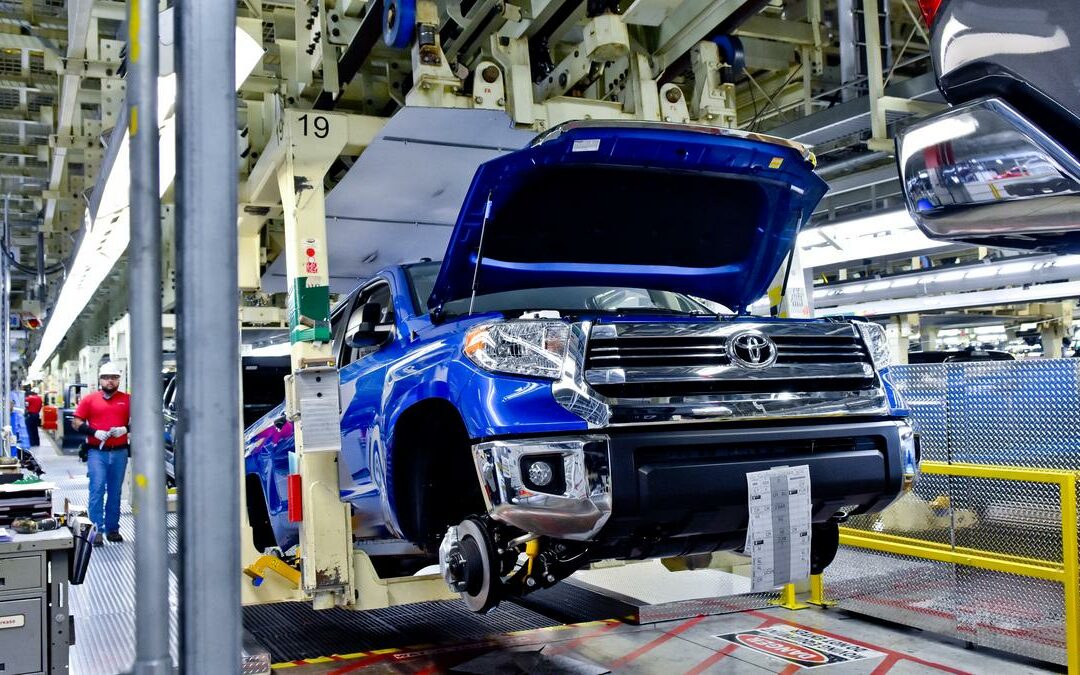
In 2025, more drivers are opting to “factory order” a vehicle instead of buying one off the lot. This trend began during the new car shortages of the pandemic, and has stuck around ever since. For many car buyers, factory ordering is an unfamiliar purchase process and can be intimidating. We’re here to help you make sense of it all.
Everyday on the CarEdge Community Forum we field questions such as:
We’ll address these questions (and more) below.
Let’s dive in.
The steps to factory order a car isn’t too terribly complicated, however, for many, it’s an entirely unfamiliar process. Because of the ongoing chip shortage, many dealerships will likely proactively ask you to order a vehicle instead of purchasing one on their lot. Here’s the roadmap for factory ordering a car in 2025:
The simple “18 steps to factory order a car” … Simple, eh? Let’s break things down a bit more.
Can you negotiate on a factory order car? Yes, yes, yes. You can, and you should negotiate the price of your factory ordered vehicle.
There is a common misconception that because you are “custom ordering” a vehicle you cannot negotiate with the dealer, simply because it is “custom”. That couldn’t be further from the truth. From the dealership’s perspective a factory order is just like any other car deal. It’s a piece of inventory that they’ll make front-end and back-end profit on. As a customer, you should treat it the same way too.
So when do you negotiate on a factory order? At the time of placing the order. Not when you take delivery of the vehicle!
This is another common misconception when it comes to factory ordering a car. You need to negotiate when you first place the order, not when you take delivery. Why? Because the dealership treats the ordered vehicle similarly to any other sales. When your salesperson/sales manager is putting together the “deal jacket” (industry lingo for all the paperwork associated with your car deal), they will have an out-the-door (OTD) price associated with the deal. That OTD price shouldn’t be MSRP + fees + taxes + tags/registration. Instead, if you negotiate with them it should be MSRP – dealer discount + fees + taxes + tags/registration.
Enjoying this guide Check out The Car Buyer’s Glossary of Terms, Lingo, and Jargon
If you don’t negotiate with them then, the assumption is that the deal is at MSRP, and your leverage (once the vehicle is on the dealer’s lot) is lesser. Especially in the current market where inventory is so scarce.
It’s also important to negotiate the price upfront, because you want to “lock-in” the price so that there are no surprises when you finally take delivery. More on that below.
What can you negotiate when you factory order a vehicle? It’s simple, all the same things you would negotiate when you purchase a car off the lot. Remember, if it’s taxable, it’s negotiable!
Negotiate on taxable fees (doc fees, processing fees, etc.), and on the vehicle’s selling price. In today’s market be prepared to negotiate off additional dealer markup. This has become very common because of the lack of supply.
We encourage you to read success stories from other CarEdge community members to hear what types of deals they have been able to secure, and how they did it.
Manufacturers incentives are applied at the time you take delivery of the vehicle, not at the time of placing the order. For example, if you order a truck today you will negotiate the OTD price with the salesperson and sales manager today. You will then take delivery of the truck 8 weeks later. At that time you will be eligible for any applicable manufacturer incentives that are currently active. You will not be able to retroactively receive the incentives that were in place when you ordered the vehicle.
That being said, you can ask the sales manager to see if they can “lock-in” the current incentives on the deal, however they likely will not be able to.
Negotiating a factory ordered vehicle is very similar to negotiating a vehicle that is on the dealer’s lot. If you are unfamiliar with that process, please consider going to Deal School, or signing up for a CarEdge Membership so that we can help you.
That being said, there is one distinct difference between negotiating a vehicle on a dealer’s lot and one that is ordered. That distinction is floor-plan assistance.
What the heck is floor-plan assistance you wonder?
You may be more familiar with “holdback” which is a form of “under the line” profit that dealerships collect from the manufacturer. In addition to holdback, dealerships also receive floor-plan assistance and advertising assistance from their manufacturer.
Floor-plan assistance is a set aside amount of money for each vehicle (it appears on most dealer invoices) that the manufacturer gives to the dealership to offset the interest expense associated with “floor-planning” the vehicle. You may not have known this, but car dealerships do not pay cash for their inventory. They finance it, just like you or I would. That means they have an interest expense on each vehicle that is on their lot.
Floor-plan assistance helps offset this cost for the dealership.
Why is this important? Because since you are factory ordering your vehicle and will likely take delivery within a few days of it arriving at the dealership, the dealer will not incur any meaningful interest expense. That means the floor-plan assistance from the manufacturer is pure profit for them.
As you can tell by now, factory ordering a car is very similar to purchasing a vehicle straight off the dealer’s lot. It isn’t too terribly different, however there are some distinct changes in the process. That being said, are there any particular “red flags” you should watch out for when placing a factory order? The answer is “yes”.
This is a major red flag. If the dealership isn’t willing to negotiate on the price when you place the order you can guarantee that two things will happen when the vehicle does arrive:
We’ve heard too many stories of people “ordering” a vehicle and not negotiating the price in advance, only to have a nasty surprise when it finally does arrive at the dealership.
Dealer-installed accessories are added by the dealer when they receive a vehicle. You’ve likely seen these on an OTD price worksheet in the past. Things like wheel locks, or LoJack are common dealer-installed accessories.
A common line you’ll hear from a salesperson or sales manager is “we can’t take that off, we put it on every car.” Well, the great thing about factory ordering a vehicle is that the dealership doesn’t have to install any of their accessories, because you’ll take delivery as soon as the vehicle arrives.
If the dealership is persistent about not removing them, that’s a red flag, because it’s a truly illogical argument.
You’ve negotiated your OTD price and you’re ready to put down a deposit to hold the vehicle. Woohoo! The only way to really make the agreed upon OTD price legitimate is to have a mutually signed buyer’s order. That, plus the deposit and the signed build sheet, make it clear that the price is the negotiated price.
If a dealership won’t sign a buyer’s order, that’s a red flag. You don’t want to arrive the day your vehicle is ready only to find out that the negotiated selling price you had is no longer agreeable to the dealership (this has been happening with more and more frequency as of late), and the only way to protect yourself from that is to have the signed agreement.
If they won’t do it, that’s a no-go.
When you factory order a car you will need to put down a deposit on the vehicle. This is typically $500 to $1,000. If the dealership does not request a deposit, or if they won’t accept your deposit, that means the vehicle you’re “ordering” isn’t really your vehicle. Just like the signed buyer’s order, if you can’t get a deposit down, you’re in for a rude surprise when the vehicle finally does arrive.
To “lock-in” your build and the OTD price, have both the dealership and yourself sign a buyer’s order, and put down the requisite deposit amount that they require.
This is an unfortunate, albeit common occurrence. If you’ve followed our steps and placed an order and then the dealership has gone silent, be sure to go up the chain of command at the dealership to contact someone in a leadership position to get information about your order. This is all about being your own advocate. We encourage you to use our email templates when contacting the dealership.
Have other questions about factory ordering? Please post them on the CarEdge Community here: https://community.caredge.com/home
We hope this helps. Please consider sharing it with anyone you know who might find it valuable.